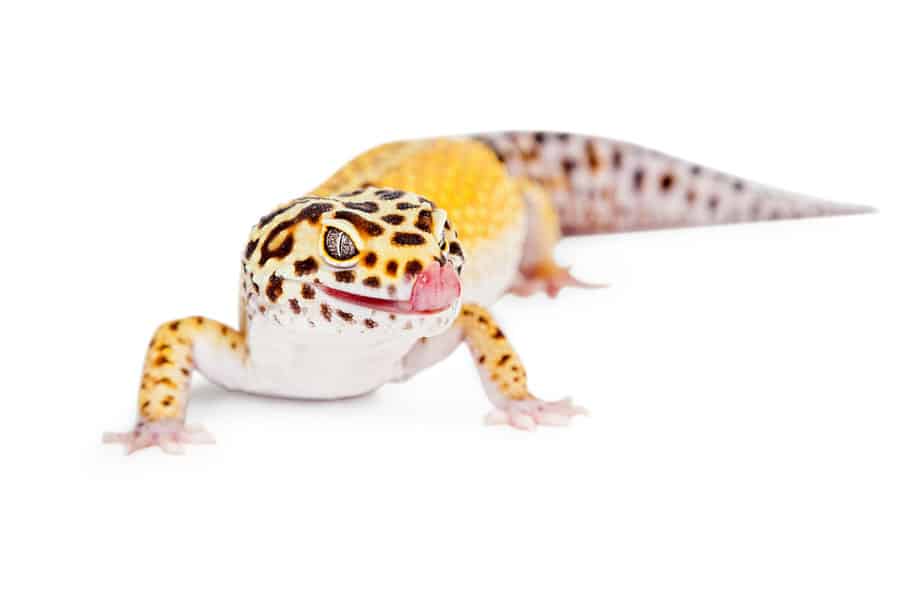If there’s one thing every leopard gecko owner should know, it’s that these reptiles thrive on worms. But can they eat all types of worms? And more specifically, can they eat butterworms?
Leopard geckos can eat butterworms. Not only are they safe to eat but they are also rich in protein, fat, and water. This makes them a great option for sick leopard geckos. However, they can be heavy on a gecko’s digestive system, making them regurgitate.

What are Butterworms?
Native to Chile, butterworms are the larval stage of Chilean Moths – Chilecomedia Moorei. Also known as Tebo worms, they have soft bodies and look like maggots.
They are orange and have a black dot on their ends, earning them the nickname Cheeto worms. In South America, they are popularly used as fishing bait. While butterworms vary in size, they usually grow up to 2 to 3 cm.
What nutrients can butterworms provide to your leopard gecko?
The major nutrients present in butterworms are:
- Protein
15.5% of a butterworm’s mass is protein. This nutrient is useful in a variety of your leopard gecko’s bodily functions. These include muscle building, organ function, and cell repair.
- Fat
Fat accounts for a whopping 29.4% of a butterworm’s mass.
Feeding your leopard gecko butterworms can provide them with fatty acids that can make the absorption of vitamins A, D, E, and K easier. Also, it can help your leopard gecko build fat reservoirs that they’ll need during strenuous activities like egg-laying.
Ultimately, it’s not surprising that butterworms are usually recommended for leopard geckos who are sick or have lost a significant amount of weight.
Just ensure you don’t give healthy leopard geckos butterworms too often though. This can quickly lead to obesity.
- Moisture
Butterworms contain 60.2% of water, meaning they can help rehydrate your leopard gecko, especially if it refuses to drink any water you offer.
- Calcium
Every kilogram of butterworms contains 125 mg of calcium. While this is a good amount, it isn’t enough for your leopard gecko, especially considering that the same amount of butterworms contains 2250 mg of phosphorus.
This brings the calcium to phosphorus ratio of these worms to 0.06:1 – a figure that is far off from the ideal 2:1.
Related: Try feeding your leopard gecko superworms
What are the disadvantages of feeding butterworms to your leopard gecko?
Relying on butterworms for most of your leopard gecko’s meals can lead to obesity and even metabolic bone disease.
It can also be tough on your leopard gecko’s digestive system and lead to regurgitation.
Butterworms should be fed to your leopard gecko as rare treats.
Another disadvantage of feeding your leopard gecko butterworms is that these worms can’t be gut-loaded. This is because they only eat leaves from Tebo trees, and these can be difficult to find.
In fact, during natural disasters, many of these trees can be damaged, leading to a shortage of butterworms in the market. And even if you do find them, there’s no guarantee that your leopard gecko will like these worms – some geckos don’t like how they taste.
How do you store butterworms before feeding them to your leopard gecko?
If you do manage to buy some butterworms, you can easily store them in a plastic cup that has some substrate in it.
Afterward, place the cup in your refrigerator door – the temperature here is usually cool enough to keep them from pupating. The good news is that you don’t even need to provide these worms with any food or water, and you can keep them in this state for up to 3 months.
\When you’re finally ready to feed them to your leopard gecko, all you have to do is take them out of the fridge and let them warm up for about an hour before serving.
How to feed your leopard gecko butterworms
Ideally, you should only feed your leopard gecko 2 to 3 butterworms once a week unless they are sick or underweight. You can increase the frequency to once or thrice a week in such cases.
Just ensure you start small and monitor how your leopard gecko takes the butterworms. This will keep you from overwhelming your reptile’s digestive system.
Another thing to remember is to dust your butterworms with calcium powder a few minutes before feeding time – this will counteract all the phosphorus they have.
Related: Can leopard geckos eat hornworms?
Final thoughts
While butterworms are safe and nutritious for leopard geckos, they should be offered in moderation.
Their high fat content and low calcium content makes them unsuitable to be a staple meal for your reptile. But when combined with other food options, they are quite beneficial.
So if you have a chance to get some butterworms for your leopard gecko, don’t hesitate – they may enjoy them immensely!
